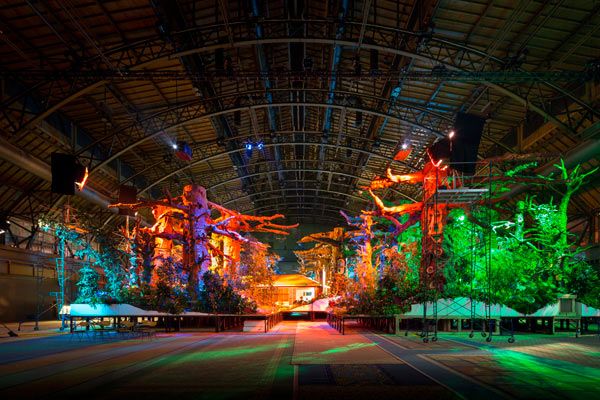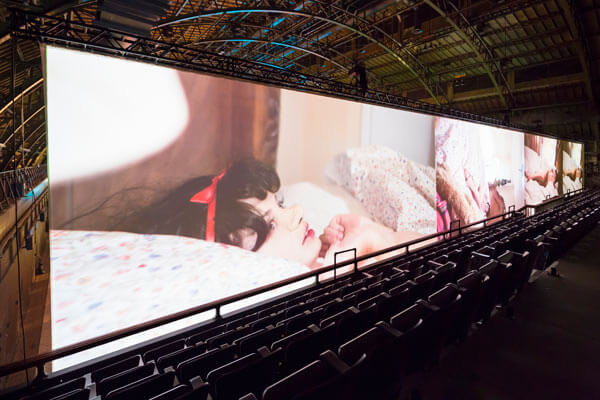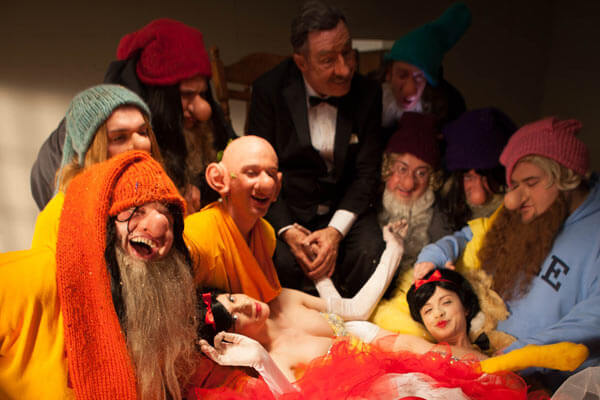Over a weekend in June, two performance art events at opposite ends of the isle (physically and symbolically) invited comparison, between the accessible and obscene, modest and epic, inclusive and restricted. Andrew Schneider’s Tidal at the River to River Festival on Pier 15 was a singular performance, while Paul McCarthy’s WS at the Park Avenue Armory will continue relentlessly into the summer.

Andrew Schneider – Photo by H. Paul Moon
Curated by Laurie Anderson, Tidal was an inventive combination of performance, sound design, and live video. Schneider’s manipulation of time-based media from live sources, evocative of pioneering works by R. Luke DuBois, drew its diverse audience into an unexpected “twist” coming from abstract linguistics—once people got it, smiles spread like a tidal wave, while occasional snickering about the avant-garde got subsumed by the pride of each figuring it out. This brought to mind how Laurie Anderson herself changed the medium, bringing levity and audience connection into this experimental art, and her choice of Tidal couldn’t have been more appropriate for the River to River Festival’s mission. It was an idyllic evening right after summer solstice under a full moon that you just can’t design.
But design is everything at WS, and nothing can prepare you for it. On the way in, you see signs cautioning that it is explicit. The person who collects your $17 at the box office says it too, and when you present your ticket and get your hand stamped at the drill hall door, you’re warned one last time. Known for interactive and epic productions in New York City’s largest performance space—from INUKSUIT to OKTOPHONIE—this is the first time that the Park Avenue Armory has banned minors, or for that matter walks a tightrope of substantial artistic and financial risk.

Paul McCarthy, WS – Image courtesy the artist and Hauser & Wirth | Installation photo by James Ewing
It helps to experience the work without thinking whether it was worth it—from the reported 85 semi trucks necessary to haul this twisted fantasy across the country, to your $17 that you will never see again. The layout of the hall is really four parts: a four-channel video work mirrored on each end; a trashed movie set-like re-creation of McCarthy’s childhood home into which you peek like a voyeur; a Disney-esque enchanted forest that doesn’t quite feel right; and side rooms of more explicit content, that you could call peepshows, or something like DVD behind-the-scenes extras. Taking this all in, it’s irresistible to admire the scale, the vision, and just the fact that no one else has dared to try anything like it.
Your visit starts with that trashed house, and its loving detail to filth. On the big screens, you see a four-angle film explaining how it got that way: Snow White’s seven dwarfs had a party that got out of hand, where Walt Paul (Paul McCarthy himself impersonating Disney) was the leader of the pack. Everyone drank, Snow White got raped, and Walt got a broomstick shoved up his ass so far that it came out of his mouth (visually realized, ironically, by ex-Disney “imagineers” whom McCarthy hired for creating prosthetics and other sadistic illusions straight from Hollywood’s book of magic).

Paul McCarthy, WS – Image courtesy the artist and Hauser & Wirth | Installation photo by James Ewing
The aftermath looks like Ron Mueck hyper-realism gone gang-banging, as you peek through cutouts in the set piece to see the murdered corpses of Walt with some woman (maybe WS herself, who is Snow White in reverse). McCarthy’s idiomatic scatological smears are all over the place, teased by the placement of a Hershey’s syrup bottle in the room. I think there was a Hummel figure sitting on the agape dead face of Walt, and other cheery things like a Christmas tree. It all felt sort of Fluxus.
No one could miss the theme that McCarthy is going for, and WS won’t stimulate conversational analysis any longer than the time it takes to say, “that’s fucked up.” Weirdly, the clearest didactic is outside the hall in a gift shop called Walt Paul Store, where it’s hard to answer “the-joke’s-on-whom.” Disney merchandise gets re-sold there with old-skool red tags from a pricing gun, at mark-ups more obscene than all that scatology in the drill hall. Clean-cut staff stand behind the vintage glass counter packed with toys, wearing striped, buttoned-down oxfords. It had seemed to me like a clever way to drive home the larger work’s sneer at Disney’s poisonous cultivation of unthinking consumption worldwide, while being inconceivable as a retail shop. Only later, I caught word of the production’s ambition to recover its sizeable costs through sales there, and that visitors already were eating it up. That’s either the coolest performance art stunt I’ve ever seen (Pavlovian proof of pop), or a sinful violation of the WS motive (let ’em eat cake). To make things more confusing, McCarthy scribbled all over the merchandise in that tiresome manner we know well in the art word, to add quick celebrity value without sweat equity. Several media outlets have noted that “Disney declined to comment” (insert word “lawyers” between “Disney” and “declined”).

Paul McCarthy, WS – Image courtesy the artist and Hauser & Wirth | Installation photo by Joshua White
Is it performance art? Arguably. Paul and his son/collaborator Damon explain that moving the piece across the country is performance in itself. And even though the video elements are fixed media, that performance grew from a raunchy occupation of the very art pieces that WS visitors experience in aftermath, as they become part of the performance. Damon estimates that the surround-sound design for the four-channel video has some 50 layers, and its complexity is a sort of abstract music that you hear all around the drill hall as a theatrical element. The piece is envisioned to evolve, after its “performance” in New York City, with changes to the video edit and to the overall narrative.
Whether WS can even survive after this stop along the way remains to be seen. Art inevitably is a business, and we find in this piece the most extreme test of sustainability (through August 4 and beyond). At this scale, in this partly time-based medium, curating and collecting the piece seem beside the point. It brings to mind Matthew Barney’s The Cremaster Cycle, which did produce some objects into the art market, but mostly came and went as events paired with films that will never be available for mass distribution (perhaps mostly forgotten by now, after all that hype). WS, at its much larger scale, leaves the visitor with a simple thought: “How can they pay for all of this?”
Even if that Walt Paul Store turns a grand profit on gullibility, it is healthy to check your accounting at the door and simply pay respect to such scale and ambition while it lasts. Then in regression, you may wind up standing in front of a projection in one of those side peep shows, watching the prince who was meant for White Snow screwing a vaguely human featureless sculpture, and it will occur to you that McCarthy didn’t just create expensive erotic fantasies. He is showing a little of ourselves, in pursuit of objects to dominate, in clean and sanitized packaging, only to safely destroy them—even if “the fairest of them all” is just around the corner. Disney, as we know, worked hard to make that feast microwave-ready.























